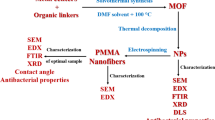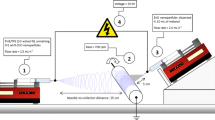Abstract
In the present work, zinc sulphide (ZnS) nanoparticles are synthesized via solvothermal route using different capping agents. The sphalerite phase is detected by X-ray diffraction (XRD) analysis. The morphology of the nanoparticles is confirmed by scanning electron microscopy (SEM) and high resolution transmission electron microscopy (HRTEM). The average particle size is found between 5 and 7 nm as calculated by HRTEM analysis. Energy dispersive X-ray spectroscopy (EDX) specified the desired elemental composition. Bandgap studies are done by UV–visible absorption and the photoluminescence spectroscopy (PL) gives the emission peaks centered at 452 nm and 460 nm. Fourier transform infra-red spectroscopy (FTIR) of ZnS nanoparticles confirmed the presence of various functional groups and showed the encapsulation of capping agents. The cylindrical non-woven network of PAN-ZnS nanofibers synthesized by electrospinning technique as confirmed by SEM and the distribution of nanoparticles in the polymer matrix is confirmed by HRTEM analysis. EDX and FTIR showed the incorporation of ZnS nanoparticles in polymer matrix. The objective of the present work is to synthesize the PAN-ZnS composite nanofibers for antibacterial applications. To the best of our knowledge this type of studies using polyacrylonitrile (PAN) as a polymer are not found in the literature showing the novelty of our work.
Graphical Abstract
















Similar content being viewed by others
References
P. Nehra, & R. P. Chauhan, Antimicrobial activity of magnetic nanostructures, In Magnetic Nanostructures (Springer, Cham. 2019), pp. 301–318.
R. Gomaji Chaudhary, J. A. Tanna, N. V. Gandhare, A. R. Rai, and H. D. Juneja (2015). Adv Mater Lett. https://doi.org/10.5185/amlett.2015.5901.
S. Tang and J. Zheng (2018). Adv Healthc Mater. https://doi.org/10.1002/adhm.201701503.
W. Salem, D. R. Leitner, F. G. Zingl, G. Schratter, R. Prassl, W. Goessler, et al. (2015). Int J Med Microbiol Suppl. https://doi.org/10.1016/j.ijmm.2014.11.005.
Y. T. Prabhu, K. V. Rao, V. S. Sai, and T. Pavani (2017). J Saudi Chem Soc. https://doi.org/10.1016/j.jscs.2015.04.002.
C. Kokkinos (2019). Nanomaterials. https://doi.org/10.3390/nano9101361.
F. Huo, Y. Wang, C. You, W. Deng, F. Yang, and Y. Pu (2017). J Mater Sci. https://doi.org/10.1007/s10853-017-0797-z.
S. Vijayan, C. S. Dash, G. Umadevi, M. Sundararajan, and R. Mariappan (2021). J Clust Sci. https://doi.org/10.1007/s10876-020-01923-3.
N. Hebalkar, A. Lobo, S. R. Sainkar, S. D. Pradhan, W. Vogel, J. Urban, and S. K. Kulkarni (2001). J Mater Sci. https://doi.org/10.1023/A:1017910131081.
P. Iranmanesh, S. Saeednia, and M. Nourzpoor (2015). Chin Phys B. https://doi.org/10.1088/1674-1056/24/4/046104.
P. Agarwal (2021). Appl Phys A. https://doi.org/10.1007/s00339-020-04237-3.
J. Geng and G. Song (2013). J Mater Sci. https://doi.org/10.1007/s10853-012-6767-6.
N. Liu, L. Zhu, Z. Li, W. Liu, M. Sun, and Z. Zhou (2021). Biomater Sci. https://doi.org/10.1039/D1BM00782C.
F. Bafande, M. Sheikh Arabi, Jorjani. Biomed. J. (2022) http://goums.ac.ir/jorjanijournal/article-1-879-en.html
K. E. Mosaad, K. R. Shoueir, and M. M. Dewidar (2021). J Clust Sci. https://doi.org/10.1007/s10876-021-02195-1.
T. C. Xu, D. H. Han, Y. M. Zhu, G. G. Duan, K. M. Liu, and H. Q. Hou (2021). Chin J Polym Sci. https://doi.org/10.1007/s10118-021-2516-0.
S. Liu, H. Shan, S. Xia, J. Yan, J. Yu, and B. Ding (2020). ACS Appl Mater Interfaces. https://doi.org/10.1021/acsami.0c06922.
X. Yang, B. Wang, D. Sha, Y. Liu, J. Xu, K. Shi, et al. (2021). Polymer. https://doi.org/10.1016/j.polymer.2020.123155.
R. Sedghi, N. Sayyari, A. Shaabani, H. Niknejad, and T. Tayebi (2018). Polymer. https://doi.org/10.1016/j.polymer.2018.03.045.
P. Zhu, H. Ou, Y. Kuang, L. Hao, J. Diao, and G. Chen (2020). ACS Appl Mater Interfaces. https://doi.org/10.1021/acsami.0c07995.
H. M. Ibrahim and A. Klingner (2020). Polym Test. https://doi.org/10.1016/j.polymertesting.2020.106647.
C. Gualandi, A. Celli, A. Zucchelli & M. L. Focarete, Nanohybrid materials by electrospinning. In: Organic-inorganic hybrid nanomaterials (Springer, Berlin, 2014), pp. 87–142
G. Panthi, R. Ranjit, S. Khadka, K. R. Gyawali, H. Y. Kim, and M. Park (2020). Adv Compos Hybrid Mater. https://doi.org/10.1007/s42114-020-00141-9.
B. D. Cullity, Elements of X-ray Diffraction (Addison-Wesley Publishing, Boston, 1956).
A.R. Stokes, A.J. Wilson, Proc. Phys. Soc. (1926–1948). https://doi.org/10.1088/0959-5309/56/3/303
G. K. Williamson and R. E. Smallman (1956). Philos Mag. https://doi.org/10.1080/14786435608238074.
G. B. Harris (1956). Mag J Sci Lond Edinb Dublin Philos. https://doi.org/10.1080/14786440108520972.
X. Zhou, Q. Yang, H. Wang, F. Huang, J. Zhang, and S. Xu (2019). J Mater Sci: Mater Electron. https://doi.org/10.1007/s10854-018-0378-1.
J. Tauc and A. Menth (1972). J Non-Cryst Solids. https://doi.org/10.1016/0022-3093(72)90194-9.
H. Labiadh, K. Lahbib, S. Hidouri, S. Touil, and T. B. Chaabane (2016). Asian Pac J Trop Med. https://doi.org/10.1016/j.apjtm.2016.06.008.
G. Murugadoss and V. Ramasamy (2013). Luminescence. https://doi.org/10.1002/bio.2363.
D. C. Onwudiwe, C. A. Strydom, R. M. Vala, and L. Tichagwa (2015). SRIM-ON-MC. https://doi.org/10.1080/15533174.2013.862696.
R. Nirmala, K. Jeon, R. Navamathavan, B. S. Kim, M. S. Khil, and H. Y. Kim (2013). J Colloid Interface Sci. https://doi.org/10.1016/j.jcis.2013.01.057.
M. A. Aboelwafa, A. M. Abdelghany, and M. S. Meikhail (2021). Biointerf Res Appl Chem. https://doi.org/10.33263/BRIAC116.1433614343.
E. K. Zarrindokht and C. Pegah (2011). Afr J Microbiol Res. https://doi.org/10.5897/AJMR10.159.
Acknowledgements
One of the authors (Lalita Rani) is thankful to UGC, New Delhi, India for the financial support provided in terms of Junior Research Fellowship. Authors acknowledge the Director, NIT Kurukshetra, India for providing various facilities in the department. We are also thankful to SAIF/CIL laboratory of Punjab University, Chandigarh for providing HRTEM facility.
Author information
Authors and Affiliations
Contributions
LR: Problem formulation, conceptualization, performed experiment, writing the original draft and prepare the final manuscript. R.P.C.: Helped in finalizing the problem and analysis of the results, review and editing.
Corresponding author
Ethics declarations
Conflict of interest
The authors declare that they have no conflict of interest.
Additional information
Publisher's Note
Springer Nature remains neutral with regard to jurisdictional claims in published maps and institutional affiliations.
Rights and permissions
Springer Nature or its licensor holds exclusive rights to this article under a publishing agreement with the author(s) or other rightsholder(s); author self-archiving of the accepted manuscript version of this article is solely governed by the terms of such publishing agreement and applicable law.
About this article
Cite this article
Rani, L., Chauhan, R.P. Antibacterial Activity of Solvothermally Synthesized PVP/EDTA Encapsulated Zinc Sulphide Nanoparticles Embedded in Polyacrylonitrile (PAN) Electrospun Nanofibers. J Clust Sci 34, 1789–1804 (2023). https://doi.org/10.1007/s10876-022-02353-z
Received:
Accepted:
Published:
Issue Date:
DOI: https://doi.org/10.1007/s10876-022-02353-z




